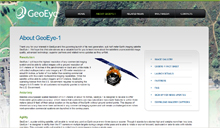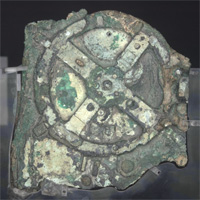Archive for the ‘Geekery’ Category
Posted by //
Sean
Date //
Sep 10, 08 - 7:26 am
Categories //
Geekery
Google
Technology
Videos
Comments Off on Google, REM And The Large Hadron Collider (LHC)
So today was the big day for the Large Hadron Collider to fire up and possibly create black holes that would gobble up the Earth and Google celebrated with a light speed inspired Google logo:
Here’s a little nugget about the LHC:
The Large Hadron Collider (LHC) is being built in a circular tunnel 27 km in circumference. The tunnel is buried around 50 to 175 m. underground. It straddles the Swiss and French borders on the outskirts of Geneva.
It planned to circulate the first beams 10th September 2008. First collisions at high energy are expected about a month later with the first results from the experiments soon after.
The LHC is designed to collide two counter rotating beams of protons or heavy ions. Proton-proton collisions are foreseen at an energy of 7 TeV per beam.
If you want to find out more about the Large Hadron Collider, check out the official website which is loaded with all sorts of geektastic information to make your head spin.
To quote the band R.E.M. from the video below, did you think it was “the end of the world as we know it?”:
I don’t know about you, but I was slightly worried about the Earth being sucked into a black hole. I know, such a nice thought as I was getting ready for bed last night.
Posted by //
Sean
Date //
Sep 8, 08 - 9:02 am
Categories //
Geekery
Google
Technology
Comments Off on Google Launches Mapping Satellite
 Google has expanded its reach into space with the successful launch Saturday of a new satellite that will provide the company with exclusive images for its maps.
Google has expanded its reach into space with the successful launch Saturday of a new satellite that will provide the company with exclusive images for its maps.
After an 11:50 a.m. takeoff from Vandenberg Air Force Base in California, the GeoEye-1 satellite relayed a downlink signal to a ground station in Norway, confirming that it had separated from its United Launch Alliance Delta II rocket and had begun to initialize its onboard systems.
The satellite launch was coordinated by terrain mapping company GeoEye. “Based upon the data we saw, the satellite is performing properly and ready to begin the next phase towards meeting its mission requirements,” said Bill Schuster, GeoEye chief operating officer, in a statement.
GeoEye said the 4,310-pound satellite required calibration and check-out period before the company would sell its images.
Although GeoEye did not mention Google in any of its announcements regarding the satellite, the search engine giant’s name appeared on the satellite and company founders Sergey Brin and Larry Page attended the launch, according to reports.
GeoEye said it plans to sell the images to customers around the world, but a Google spokesperson said that Google has exclusive rights to the images for commercial maps.
“The imagery from GeoEye-1 adds to the quantity and quality of that currently provided by our IKONOS satellite, and together this magnificent constellation will enable us to meet world-wide customer demand,” Matthew O’Connell, GeoEye CEO, said.
GeoEye-1 is part of the National Geospatial-Intelligence Agency (NGA), NextView program, which aims to obtain timely and accurate commercial satellite imagery.
It will collect 0.41-meter ground resolution black and white images and 1.65-meter color images simultaneously. It can show objects as small as 16 inches. U.S. licensing restrictions limit commercial images to a half-meter ground resolution.
The satellite can capture the images from 423 miles above the Earth and travel about 4.5 miles per second.
General Dynamics Advanced Information Systems in Gilbert, Ariz., built the satellite, while ITT in Rochester, N.Y., developed the imaging system. ITT is building another imaging system for GeoEye-2, which is scheduled to launch in 2011.
GeoEye said it won a $500 million NextView contract four years ago, and it built and launched the satellite with no cost overruns.
Source: GeoEye-1 Launch Site
Posted by //
Sean
Date //
Aug 7, 08 - 9:31 pm
Categories //
Geekery
Technology
Web
Comments Off on A Cool New Web Application: Fuelly
 I’m always on the look out for new and exciting web applications and today I was introduced to a really cool one called Fuelly.
I’m always on the look out for new and exciting web applications and today I was introduced to a really cool one called Fuelly.
So what is Fuelly you might be wondering? Fuelly is a site that tracks your gas mileage over time, helping you save fuel and expenses as you drive.
If you want to stalk my MPG, you can find me over at my Fuelly profile.
It’s pretty easy to use the site as well.
Basically you sign up for a free account, add a car to your profile, then either keep track of miles driven between fuel-ups (using your car’s tripometer) or record your odometer at each fuel-up (you can choose in your settings which way to record mileage).
For technology geeks like myself who are always connected, you should check out the mobile version of Fuelly for adding data right from the gas pump. I checked it out on my BlackBerry. It looked really nice.
As an added bonus, they even have a blogtastic development blog to keep everyone up-to-date on the upcoming changes, features, bug fixes, etc.
The service is still really new… barely live 24 hours but I see this application really taking off. If you end up registering account, let me know so we can be gas mileage stalking buddies ![]()
Posted by //
Sean
Date //
Jul 31, 08 - 7:58 am
Categories //
Geekery
Technology
Toys & Gadgets
Comments Off on Ancient Olympic ‘Computer’ Calculated Dates
 Researchers announced Wednesday that a geared device dating to the second century BC was used to calculate the dates for the first Olympic games.
Researchers announced Wednesday that a geared device dating to the second century BC was used to calculate the dates for the first Olympic games.
It has long been known that the Antikythera Mechanism — recovered in 1900 or 1901 from a shipwreck off the Greek coast — was able to calculate and display celestial information, including cycles and phases of the moon and sun.
Now, newly deciphered inscriptions on the device referencing the Olympics, and a dial designed to calculate the four-year Olympiad Cycle, reveal more about the device and how it was used by the Greeks.
The first Olympics were held in Nemea in 776 BC. Reuters reports that “The name ‘Nemea’ was found near a small dial on the mechanism, a reference to the site of one of the prominent games in the Olympiad cycle, the researchers said. Locations such as Olympia also appeared.”
A report published Wednesday in the journal Nature says:
The Antikythera Mechanism is technically more complex than any known device for at least a millennium afterwards. Its specific functions have remained controversial because its gears and the inscriptions upon its faces are only fragmentary
Here we report surface imaging and high-resolution X-ray tomography of the surviving fragments, enabling us to reconstruct the gear function and double the number of deciphered inscriptions. The mechanism predicted lunar and solar eclipses on the basis of Babylonian arithmetic-progression cycles.
Technologists from HP joined the scientific team and contributed imaging analysis. See their amazingly detailed ‘reflectance images’ here.
If you still want more, watch a fascinating video of how researchers deciphered the purpose and properties of the mechanism.
Source: Nature Journal
Posted by //
Sean
Date //
Jul 6, 08 - 9:34 am
Categories //
Geekery
Humor
Trivia
Comments Off on Look! New Unusual Trivia on Planet Sean
It’s been a long while since I updated my Unusual Trivia page, so today I added four new entries for your reading enjoyment:
- In Michigan, it is illegal to chain an alligator to a fire hydrant.
- It is against the law to whale hunt in Oklahoma.
- Jim Morrison (of the 60’s rock group The Doors) was the first rock star to be arrested on stage.
- Sir Thomas Crapper, attributed to inventing the flush toilet, was a nephew of Queen Elizabeth.
Of course you can view lots of other funny trivia and useless knowledge by visiting my Planet Sean unusual trivia page.
If you know any fun and unusual trivia not already listed on my site, let me know. I’m always looking for fun nuggets of sliced fried gold.
Posted by //
Sean
Date //
Jun 12, 08 - 6:13 am
Categories //
Geekery
Software
Technology
Wireless
Comments Off on Video Demo Of Firefox Mobile Browser
Wow. That’s all I can say right now. It’s been about nine months since Mozilla promised to “rock the mobile Web” with its forthcoming mobile version of the Firefox browser.
If the final product bears even the slightest resemblance to the browser demonstrated in this video, every other mobile browser out there has a lot to worry about.
Aza Raskin, head of user experience over at Mozilla Labs, posted a video demonstration on a potential candidate for Firefox Mobile.
He also writes in detail some nice explanations on why Mozilla has taken this direction with mobile Firefox.
The browser seen in this demo is not a final release candidate, but it should be:
Based on using a touchscreen device, Mozilla has solved all the navigational pains associated with mobile browsing by using simple panning gestures.
Need to access the control buttons or URL bar? Pan in any direction. Most of the time, 100% of the phone’s pixels are being used to display content, not navigational controls. You only see the nav controls when you want to.
Secondly, it uses a zoom effect to control tabs. You can zoom way in and out, and set up groupings of tabs in clusters of associated content, such as communications Web sites, and so on.
Being able to cluster tabs like this is just plain cool. Because the display is a 2-D plane, you can arrange the tabs and documents in any way that you want.
I can’t wait for this to be released. Again. Wow. Lots of wow.
